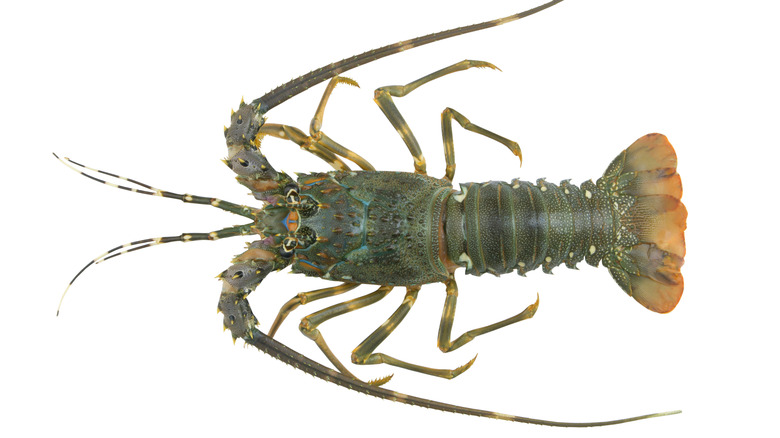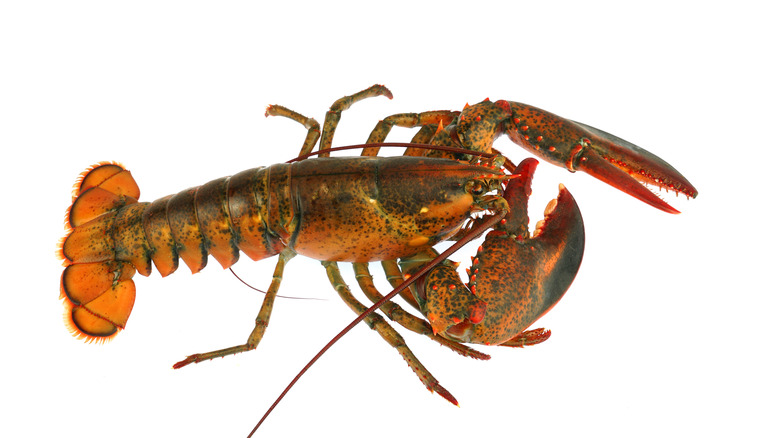The Meaty Difference Between Spiny And Maine Lobsters
When you order lobster in a restaurant, you can expect to pay a premium price. Long considered a delicacy, many people save such an entrée for special occasions and holiday feasts. But lobster didn't always have such a posh reputation. Around the time that European settlers arrived in North America, lobsters were so plentiful that they would wash up on the eastern shores in piles. Considered more of a nuisance than a food source, they were used as fertilizer and given to the lower classes of society, according to Insider. Lobster first became a desired dish in the mid-19th century when it began to be canned and shipped across the nation. People took a liking to the sweet meat and suddenly, these "cockroaches of the sea," as they were called, became a gourmet item, one that people would travel to New England to eat. Prices of fresh lobster have surged ever since.
The lobsters that gained such a reputation were Maine lobsters, not to be confused with Spiny lobsters which aren't found anywhere near their East Coast cousins. If you spotted them both separately underwater, you'd probably know you were looking at lobsters, even though there are some significant differences between them. To people who enjoy shellfish, the two taste very similar, but you can only order one of them whole.
Spiny lobsters
The lobster image that comes to mind for most people is the hard-shelled, giant-clawed, long-tailed sea creature that's often depicted as bright red-orange in color. This is an accurate description of a Maine lobster, except for the color; lobsters only turn red when they are cooked. The Spiny lobster lacks one notable feature: The giant claws. Also called Rock lobster, the Spiny lobster also has an antenna much longer than its Maine counterpart. And you won't find them in Maine or anywhere along the Northern East coast, but rather, off the warm shores of the southeastern U.S. from North Carolina down through Florida, and into Texas, via NOAA Fisheries. King's Seafood Co. mentions that Spiny lobsters are also harvested off the shores of California from October through March.
Much to the surprise of unprepared diners, when spiny lobsters are served in restaurants, they are not available whole, but only sold as tails. The reason is that there is very little edible meat outside of the tails since they lack the large claws that Maine lobsters have. To be certain, they do indeed have claws, but they are so insignificant in size that they are discarded in restaurants. The upside, according to Mainer, is that Spiny lobster tails actually have more meat than Maine ones. Spiny lobsters have the capability to grow up to 20 pounds but are usually harvested when they are between one and two pounds
Maine lobsters
Available year-round, with their numbers spiking in late summer and into fall, Maine lobsters are considered the ultimate lobster delicacy, per The University of Maine. Some refer to them as American lobster or Northern lobster, but as expected by their most common name, they are plentiful in the northeastern coastal waters, from Canada to North Carolina, with their numbers drastically dwindling the further south they go. Many restaurants offer Maine lobster in its whole form, steamed, roasted or grilled. Sometimes, diners can opt to order just the tail, where the sweet, tender meat is prized, but to do so is to miss out on the huge chunks of meat found in the claws, and some also in the body. It is all of this plentiful meat that makes them, generally, the preferred type amongst lobster aficionados.
Mainer notes that the cold water Maine lobster is cultivated in makes the meat sweeter because the icy conditions keep the meat from absorbing excess salt from the water. While it's perfectly fine to substitute spiny lobster for Maine lobster, Oceanfood Sales Limited suggests that some find spiny lobster meat less succulent and tender than Maine lobster. Their rarity could also make them more prized on a global scale; while Maine lobsters are only found in Atlantic waters, spiny lobsters are available outside of the U.S. as well, specifically off the Asian coast and in southern Brazil, per AZ Animals, and in the Caribbean Sea, as noted by NOAA Fisheries.


